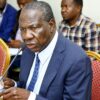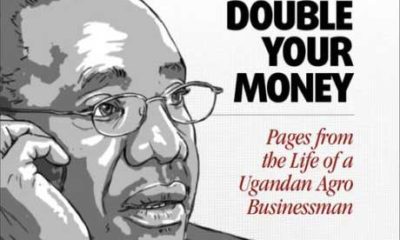Columnists
The real story behind age-limit anger
To demystify politics, every Ugandan must be included in the ‘thing’ by making economic opportunities broad-based through industrial policy!
Uganda is at cross roads. We all know where the country has come from, both politically and economically. We equally know where it is. However, we hardly know where it is heading, and how it should get where we want it to be.
The debate on Uganda’s political future turned chaotic right at the onset. Reason? The age limit debate is not about age limit or the constitution; it is about President Museveni and his long and continued stay in power.
The President’s opponents believe that the only chance remaining for them to remove him is the constitutionally entrenched requirement that a President must be under 75 years.
His supporters, on the other hand, feel that since the President can only be removed on technical grounds, then he is the right man to keep them in power. After all the “technical grounds” may be dealt with technically! This has caused a political stalemate that is likely to raise the country’s already high political risk index.
On the other front, “the economic party of the past 25 years is now over,” to use Bank of Uganda’s words. The economy has lately been performing below all targets. At an average of 4.5%, Uganda’s growth has been among the weakest in the region in the past 5 years. However, the International Monetary Fund (IMF) had projected that growth would recover to 6% next years had the economy evaded further disruptions such as the ongoing political paralysis.
Ugandans are tired
But even when the economy was growing, the growth profile itself had remained jobless, unequal, and barely sustained. Growth was happening in a low productivity sector (services) that does not create jobs. Agriculture, where three quarters of Uganda’s labour force are, has had the lowest labour productivity. Manufacturing has stagnated at about 7% of GDP for the past 40 years!
Last month, the Ministry of Finance, Planning and Economic Development (MoFPED) organised an economic growth forum to discuss the economic future of the country. The conference attracted very little interest from media and other key stakeholders. Why? Because there was hardly anything new that was said at the conference that Ugandans had not heard before.
What would be new for Ugandans? Three things: (1) Action, (2) Action, (3) Action. Dear leaders at all levels, Ugandans are tired of speeches, presentations, workshops, retreats, reviews, reports, recommendations and resolutions.
Ugandans need factories where they can supply their labour and energy that they are wasting away on streets running around with police and self-serving politicians. Manufacturing is the only sector that will provide low skilled jobs to a large number of Ugandans.
The NRM promised Ugandans, 32 years ago, in their “Ten-Point Programme” that they were going to “build an independent, integrated and self-sustaining national economy.”
They criticised the past governments, and the rest of Africa, of the failure to build manufacturing industries that used locally produced inputs. Yet in the past three decades very little has happened to change this situation.
Proactive government
As I have indicated above, manufacturing has on average contributed only 7% of Uganda’s GDP over the past four decades. During the same period, Sub-Saharan African average was 12%; while the world’s average was 19%.
Even the little manufacturing that is going on is in the hands of small and medium enterprises (SMEs). SMES account for over 90% of the enterprises in Uganda’s manufacturing.
Manufactured exports stand at just about 4% of the total exports from Uganda, themselves comprising of low value added goods such as coffee beans, primary processed food and other beverages. A large proportion of manufactured exports from Uganda are actually imported merchandise that is re-exported in the region. That is, we import from India, China, or Kenya and then we re-export to South Sudan, DRC or Rwanda
To change this picture, we need industrial policy. By industrial policy, economists mean targeted efforts to change the production structure of an economy in order to accelerate economic development.
Everywhere in the world, industrialisation required proactive government involvement. No country has ever industrialised by relying on markets as promoted by Washington Consensus. Not a single one. All industrialised nations used industrial policy – government directly investing in industry and/or subsiding FDIs – to establish robust manufacturing firms.
Uganda in “low product trap”
In 2010, a group of economists in the U.S. carried out a research entitled, “How Rich Countries Became Rich and Why Poor Countries Remain Poor.” They classified 154 countries according to two dimensions of their exports: (1) sophistication (measured by the income content); and (2) connectivity to other products (a well-connected export basket is one that allows an easy jump to other potential exports).
They found that what set apart countries were their productive structure and the specific characteristics of the products that they exported.
In the whole world, there are only 34 countries that export sophisticated and well-connected products. Twenty eight countries are in what researchers called “middle product trap.” These are countries whose export baskets contain a significant share of products that are in the middle of the sophistication and connectivity ranges.
They found 17 countries and 75 countries respectively in what they called a “middle-low” and “low product trap”. These are countries whose export baskets contain a significant share of unsophisticated products that are poorly connected to other products. Needless to say that Uganda is in the ‘low product trap’ category.
The researchers conclude thus, “Historically, it has been impossible to become a rich country without creating an industrial sector and an advanced service sector. No country has become rich without explicit government interventions that amount to industrial policy in different shapes and forms.”
Yet Uganda wants to reinvent the wheel. Last month, Africa converged in Accra-Ghana to discuss “the political economy of economic transformation.” We were hosted by Friedrich Ebert Stiftung (FES), a German political federation.
Uganda’s development agenda is uncoordinated
Germany is one of the most industrialised countries in the world, whose industrial might was built on a better understanding of the interchange between political processes and economic development.
One practical lesson I carried home from Accra was that interactions in national economies are shaped by political interests and power relations. Powerful vested interests are at all times at play to guide the flow of existing resources. Often these interests stand in the way of the much needed structural transformation which could ensure that the resource wealth benefits the wider population.
Before we headed to Ghana, each country had carried out a baseline study, where existing industrial policies and the state of their implementation were analysed. I headed the team that did one for Uganda.
Among so many interesting findings, we established that Uganda had a weak National Industrial Policy (NIP). We also found that Uganda’s development strategy (as profiled in the National Development Plans and Vision 2040) was uncoordinated and incoherent in terms of implementation.
We established that the five lead constraints undermining manufacturing in Uganda were: limited long term finances; infrastructure bottlenecks, particularly low energy for production, bad roads and no railway transport; inadequate skills commensurate with the manufacturing needs; competition from low cost producer countries; and poor quality products. Tell me, how can one deal with these constraints using markets?
For example, we found that where mechanisms have been deployed to identify the best private firms to facilitate, entrepreneurs and investors still spent most of their time seeking favours rather than on improvements, expansion and cost-reduction strategies.
Reorient resources towards industries
We found that although agencies such as the World Bank, the United Nations Industrial Development Organisation (UNIDO), African Development Bank (ADB), and others were advising Ugandan policymakers that “It is no longer considered appropriate for the government to formulate industrial master plans,” the unfettered market model buttressed by the private sector-led strategy has ended up promoting importers and multinational corporations instead of indigenous manufacturers.
The NRM should blame itself for failure to achieve point No.5 in its ten point programme. Yes, it could have gotten derailed when they were required to adopt neoliberal macro-economic frameworks and abandon industrial policy. However, no one stopped the NRM government from adopting the second-generation reforms after stabilizing the economy.
Is it too late? Not at all. Uganda can be delivered to the promised land by simply reorienting public resources and focus towards two sectors – agriculture (to supply food and raw materials) and manufacturing (to employ Ugandans and save the billions of foreign exchange spent on imports).
Much of the money that Uganda needs to develop is already available; being squandered in government and expansive statutory commissions, agencies and authorities.
Looking just into the running budget for 2017/18, government is going to squander over UGX 1,780 billion on travel, welfare and entertainment, special meals and drinks, workshops and seminars, and fuel and vehicle maintenance. My damn feeling is that this is wastage that may easily be reoriented towards building industries.
Everyone know Lukwago. Why?
Mr. President, the reason you see thousands of young people putting their lives on line confronting armed police, threatening to burn their MPs who are agitating for the removal of age limit, is not because they hate you per se or that they mind a lot about changing leaders. Ugandans are angry because your government has failed to create opportunities for them in the form of jobs and sustained livelihoods. Those with jobs or businesses are busy working or making money, and silently wishing the status quo may hold. But they are very few.
As I usually say, politics is attractive in societies where a big chunk of the population is excluded from socio-economic prosperity. Countries with jobs and sustainable business opportunities, that make life fun to live, do not mind about politics. Many people in the Nordic countries do not even know their prime ministers or presidents. They have no reason or time to know them.
It is in troubled countries (troubled by joblessness, crime, and economies that work for a few people) where people are obsessed with politics. For example, ask an average Ugandan to tell you who the President of Switzerland or the Prime Minister of Luxembourg is? What about Iceland, Denmark, Norway, Sweden or the Netherlands?
A few years ago we were in The Hague, the Netherlands and the Mayor, Mr. Jozias van Aartsen, told us nearly half of the residents of The Hague did not know him. Who in Kampala does not know Lord Mayor Erias Lukwago? Why do all Kampalans know Lukwago and the residents of The Hague don’t know Van Aartsen?
To demystify politics, every Ugandan must be included in the ‘thing’ – the economy. To include every Ugandan in the thing, we need structural change such that economic opportunities are broad-based and universal. To achieve this industrial policy to promote manufacturing will be inevitable.
Comments























